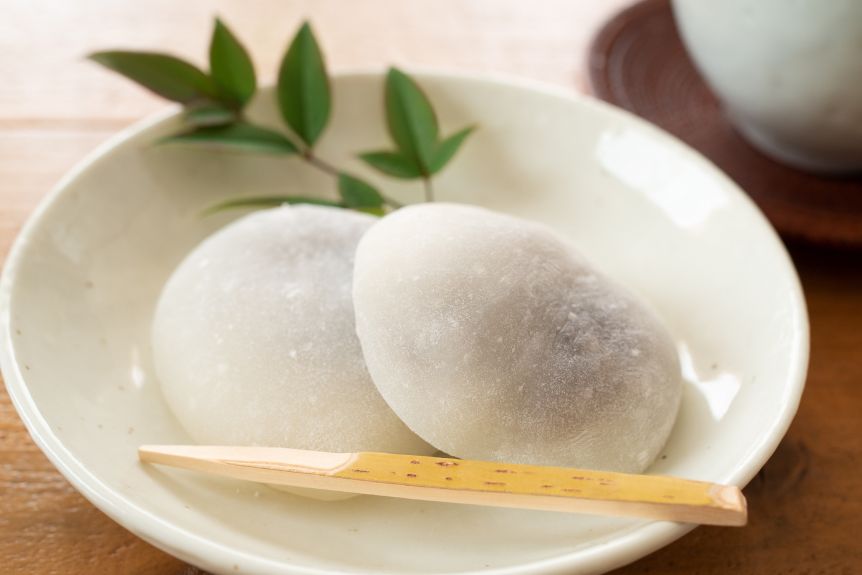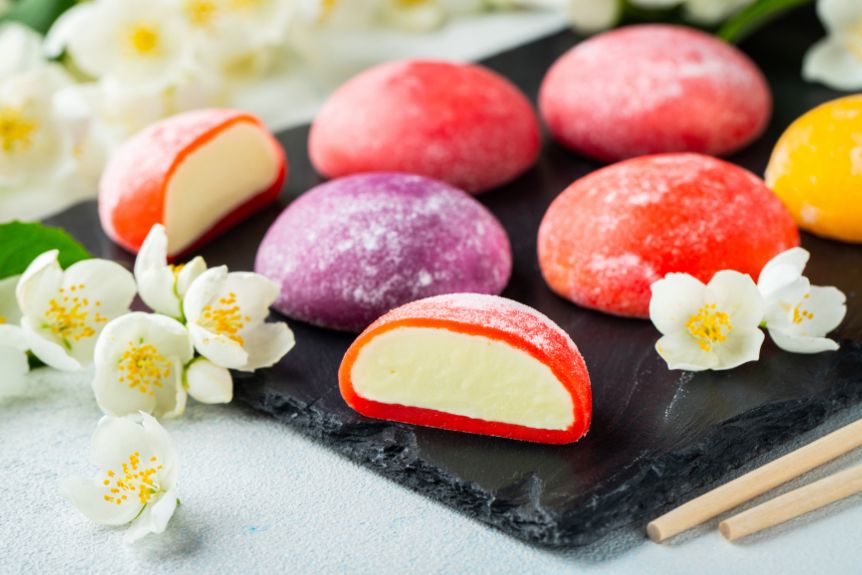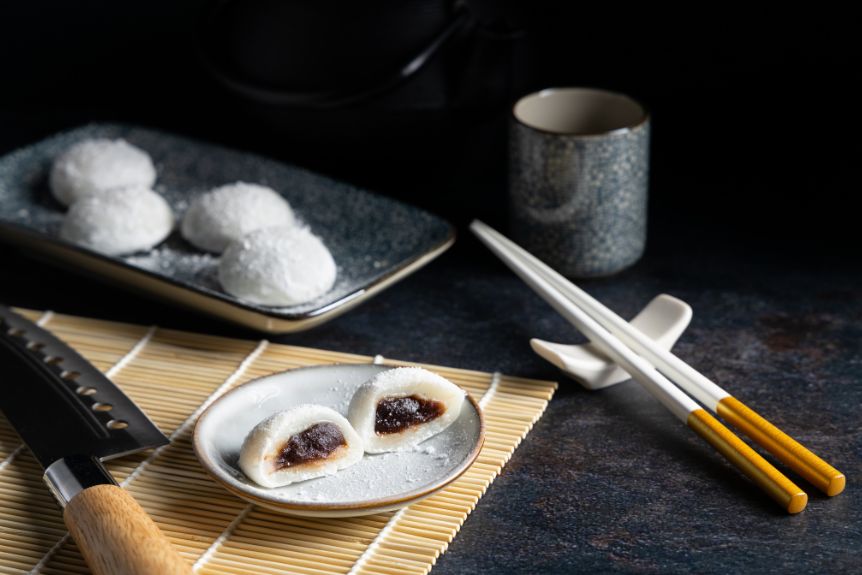Are you ready to dive into the world of delicious food? Get ready to experience the amazing texture of mochi rice, a special treat loved by foodies everywhere.
This traditional Japanese dish has a rich history and is enjoyed with great ceremony. It’s known for its chewy goodness, that keeps you coming back for more.
But what’s the secret behind mochi rice’s worldwide popularity? And how has it sparked creativity in kitchens worldwide?
Join us as we unveil the secrets behind the delightful texture of mochi rice and explore its significance in Japanese culture and its versatile uses in savory and sweet dishes.
Get ready to be captivated by the enchanting world of mochi rice!
The Origins of Mochi
Mochi’s origins trace back to ancient Japan, where it was first made as a special offering to the gods during religious ceremonies. This tradition underscores the control and respect the ancient Japanese had over their craft and spirituality.
They meticulously pounded steamed glutinous rice into a sticky, elastic dough, a process that demanded precision and patience.
You can embrace this aspect of control by understanding the meticulous process involved in mochi making. It’s not just about following steps; it’s about mastering them.
As mochi’s popularity grew, its production methods were refined, yet the essence of control remained paramount.
Families and communities came together, participating in mochitsuki, the mochi-pounding ceremony, reinforcing the importance of unity and discipline in achieving the perfect texture and consistency.
This collective effort symbolizes how control over one’s actions and cooperation can lead to the creation of something as simple yet profound as mochi.


Crafting the Perfect Texture
Achieving mochi’s signature chewy texture requires a precise balance of ingredients and technique. You’ll need to start with the right type of rice—glutinous rice, also known as sticky rice.
It’s this specific rice that gives mochi its unique chewiness. Don’t compromise here; the rice you choose is the foundation of your mochi’s texture.
Next, pay close attention to the water-to-rice ratio. Too much water and your mochi will be soggy. Too little, and it’ll be tough.
Finding that sweet spot is key. Typically, a 1:1 ratio is a good starting point, but you may need to adjust slightly based on the specific type of rice you’re using.
The cooking process is just as crucial. Steam the rice until it’s fully cooked but still firm. Overcooking leads to a mushy texture that won’t hold up during pounding.
Speaking of pounding, this is where you really take control. Pounding the rice while it’s still hot transforms it into that smooth, elastic dough mochi is famous for.
It’s labor-intensive, but don’t shy away from this step. The vigorous, consistent pounding is what ultimately creates mochi’s delightfully chewy texture.
Mochi Rice in Japanese Traditions
In Japanese traditions, mochi isn’t just food; it’s an integral part of ceremonies and celebrations, symbolizing good fortune and happiness.
You’ll find that mochi’s role goes beyond mere sustenance; it embodies connection, tradition, and the joy of shared experiences.
During the New Year, for instance, mochi plays a starring role. You’re likely to see kagami mochi, a decoration made from two stacked mochi discs, topped with a bitter orange.
This isn’t just decor; it’s a welcome to ancestral spirits, a gesture you can adopt to bring prosperity into your home.
Moreover, if you’re involved in a Japanese wedding, you’ll notice mochi’s presence there too. It’s not uncommon for guests to receive mochi as a parting gift, a symbol of the couple’s hope for happiness and wealth in their shared journey.


Versatile Uses of Mochi Rice
Building on its deep-rooted cultural significance, mochi rice also boasts an impressive versatility in culinary applications. You’ve got the power to transform this humble ingredient into a wide array of dishes, from sweet to savory, traditional to innovative.
It’s not just about the traditional mochi balls you might be familiar with; it’s about exploring the breadth of culinary possibilities. You can start by incorporating mochi rice into your desserts.
Think beyond the usual and experiment with mochi ice cream, where the chewy texture complements the creamy filling, or mochi waffles, adding a delightful twist to your breakfast routine. But don’t stop there.
Savory dishes welcome mochi rice just as warmly. You can slice it into soups for a satisfyingly chewy texture or grill it to make crispy, cheese-filled mochi squares that’ll change the way you think about appetizers.
The key here is to not be afraid to experiment. Mochi rice’s subtle taste and unique texture make it a versatile canvas for your culinary creativity.
Exploring Global Mochi Innovations
As you explore the world’s culinary landscape, you’ll find that mochi innovations span from traditional treats to avant-garde delights, showcasing the global love for this versatile ingredient.
Take control of your culinary journey by diving into these unique mochi creations from around the globe. You’ll be amazed at how chefs and food innovators have pushed the boundaries of mochi’s texture and flavor.
In Japan, artisanal shops are elevating mochi by infusing it with unconventional flavors like yuzu and matcha, blending tradition with modern taste profiles.
You’ll also find mochi being used in fine dining to add a unique texture to both savory dishes and desserts.
Venture further, and you’ll discover mochi waffles in South Korea, a perfect marriage of crispy and chewy, offering a delightful twist on a breakfast classic.
Meanwhile, in the United States, ice cream-filled mochi has surged in popularity, combining the cool creaminess of ice cream with the soft, chewy wrapper of mochi.
Take control and seek out these innovative mochi experiences. Whether you’re indulging in a gourmet restaurant or experimenting in your own kitchen, you’re at the forefront of a culinary revolution that’s redefining the way we think about mochi.
Conclusion
So, you’ve journeyed through the history and heart of mochi, discovering its origins, the craft behind that perfect chewy texture, and its deep roots in Japanese traditions.
You’ve seen how versatile mochi can be, from sweet treats to savory dishes, and even explored its global innovations.
But what if there’s a contrarian point of view? Perhaps you believe that mochi is overhyped or that its texture is too sticky for your liking. We want to hear your thoughts! Leave a comment below and let’s know your take on the delightful world of mochi.
And if you’re a mochi lover, go ahead, experiment with its versatility and let your taste buds revel in the unique, squishy goodness that mochi rice offers. Don’t forget to share your favorite mochi creations with us too!




Konnichiwa! (Hello!) I'm Pat Tokuyama, a Japanese tofu cookbook author, who travels for music, food, and adventure. If you like Japanese tea, checkout some of the newestorganic japanese tea, matcha bowls and noren and more!
** Curious about the Plant Based Japanese Cooking Club? ** Learn more here!